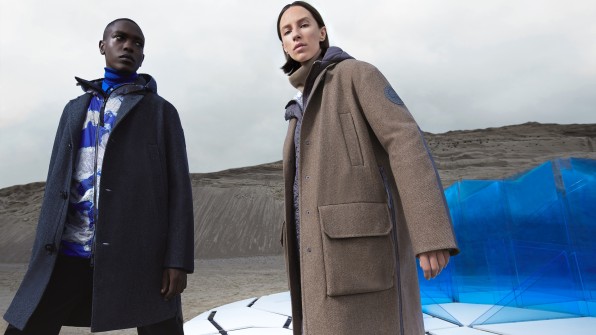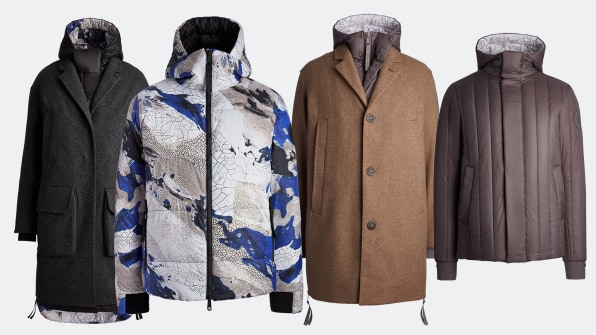My Canada Goose Is Not Warm
Diane Burko describes herself as an "artist explorer." Since 2006, she's traveled to some of the coldest places on earth to document the melting of the glaciers due to global warming. She's gone on expeditions to the three largest ice fields in the world: the Antarctic Peninsula, Greenland's Arctic glaciers, and Svalbard, 400 miles north of Norway. She then creates stunning large-scale photographs and paintings about what she sees. One of her best-known works is called the Elegy series, which she describes as "bearing witness to climate change."
From a distance, these immense canvases look like abstract art, with elaborate motifs of colors and shapes. But when you take a closer look, you see that Burko is capturing the blue hues of the water and the sharp white points of the ice. As a viewer, you experience cognitive dissonance: The images are so beautiful, but they also strike you with horror when you realize that these glaciers are rapidly disappearing, devastating the ecosystems of the North.Karuna Scheinfeld, Canada Goose's VP of design, along with other members of her design team, happened to see the Elegy series when it was showing at MoMA in New York. "We were deeply moved by what we saw," she says. "We knew we wanted to collaborate with her."

Canada Goose is launching a limited-edition series called BRANTA, which features two prints from Burko's Elegy series on six coats and parkas, three for men and three for women. (They cost between $1,395 and $2,695.) Each is aptly named for a glacier: Berendon, Leduc, Atavist, and Viedma. Several of the parkas feature a reversible element: They can be worn with either the Burko print on the exterior or with a simple monochrome quilting. When the print is worn on the interior, it still peeks out from the hood and lapel.
For Scheinfeld, the collaboration makes sense. The brand has spent decades serving explorers, scientists, and police officers who spend a lot of time in the far reaches of the Northern Hemisphere, including the very glaciers that are now in peril. Before it was popular with consumers, Canada Goose was in the business of creating heavy-duty parkas for customers such as the Canadian Rangers and researchers working for the United States Antarctic Program. One of its best-known jackets, the Snow Mantra, was specifically created for expeditions to the Antarctic. Yet, as climate change destroys the glaciers of the North, it also wreaks havoc on weather patterns, causing more extreme heat and cold elsewhere in the world. Events like the Polar Vortex and the Bomb Cyclone mean that people who live in cities in the Midwest and the Northeast of the United States might find themselves in much colder conditions than usual. "It's really unfortunate, but more of us are experiencing weather conditions usually found in the Arctic and Antarctic," Scheinfeld says.

In fact, Canada Goose is designing modular parkas and coats that are adaptable to wildly variable weather that includes milder days too. Take the Viedma coat from the BRANTA collection. Its interior layer contains a lightweight quilted down jacket, which is reversible, with a Burko print on one side and a simple black, brown, or grey quilting on the other side. On the exterior, it sports a separate wool jacket made from Loro Piana wool that repels water. The two layers can be worn on top of one another, or they can be worn separately. When it's wet but mild, you might wear the wool coat to protect you from rain, and when it's cool in the spring, you might just wear the lightweight down interior.
Other design elements are focused on adaptability too: There are side vents, for instance, which you can zip open to let air in and allow you to access base layers. And like most jackets and parkas the brand makes, these are equipped with its popular backpack straps. This allows customers to effectively take their arms out of the jacket during times they want to take it off but not have to carry it. "We want to create coats that customers can wear throughout the day, and throughout the year," she says. "This means being able to wear it in the freezing cold, but then take it off when you walk into a building or into a train without having to hold it in your hands."
This is not the first time that Canada Goose has emphasized its connection to the northernmost reaches of the planet. Earlier this year, I reported about how Canada Goose partnered with Inuit designers from Northern Canada, who created one-of-a-kind parkas using traditional designs.
The BRANTA collection reminds us that the people and the wildlife in these places may be harmed forever if we don't act to stop climate change. "I think Diane Burko's art is so brilliant because it uses beauty to show us what we might lose," says Scheinfeld. "I think beauty sometimes can be more convincing than guilt."
Source: https://www.fastcompany.com/90415028/now-you-can-wear-a-melting-glacier